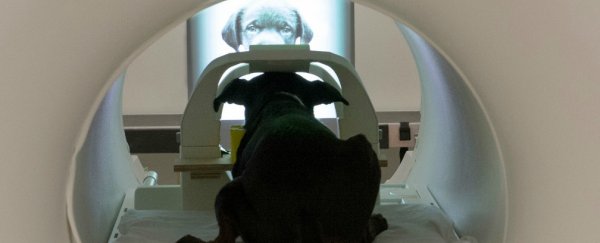Next time you're staring at your dog lovingly, rest assured that it really can recognise your face from all the other human-shaped objects in its life. Although behavioural evidence has suggested that dogs could visually differentiate human's faces, new functional MRI (fMRI) scans have shown for the first time that they have a specialised brain region just for this purpose.
This is the first time a non-primate has been shown to have a brain region dedicated to processing faces, and it not only shows that dogs really do love us, but could also provide some insight into why the species is so sensitised to human social cues.
"Our findings show that dogs have an innate way to process faces in their brains, a quality that has previously only been well-documented in humans and other primates," lead researcher Gregory Berns, a neuroscientist at Emory University in the US, said in a press release. This suggests that the ability to recognise human faces has been hard-wired through evolution, and could explain why dogs ended up becoming such good friends with humans throughout history.
Berns heads up the university's Dog Project, and they were the first research group in the world to train dogs to willingly enter and stay still inside an fMRI machine without the need for drugs or restraints. They've already used this unique ability to show that dogs recognise their owner's scent, and that it makes the reward region of their brains light up when they smell it (awww).
And now they've shown that their brains also respond in a unique way to human faces in comparison to everyday objects. To figure this out, the team showed the dogs photos and videos of human faces, dog faces, and common objects, and monitored how their brains responded.
This in itself was a challenge, because dogs don't normally interact with 2D images (hence why they never want to chat with you on Skype), so the researchers had to first teach their dog volunteers to pay attention to a screen for at least 30 seconds per image so that they had time to monitor their neural activity.
Only six out of the eight dogs managed to complete the task, but for those that did, the results were clear - when they looked at footage of human faces or of other dogs, a region in their temporal cortices lit up significantly more than it did for videos of everyday objects.
If dogs had simply learnt, but not evolved, to recognise human faces - for example, as a result of associating its owner's face with food - the researchers would have expected the reward region of the brain to light up too. But this wasn't the case.
Publishing their results in the journal PeerJ, the team has now named the region of the brain the 'dog face area', or DFA, based on the fusiform face area, or FFA, which is one of three facial-recognition regions in the human brain.
The results are obviously limited by the small sample size of dogs involved, but Berns and the team now hypothesise that perhaps facial recognition is a crucial ability in any social or 'pack' animal, such as humans, primates, and canines. And in the future they hope to find out more about how this skill evolved.
"Dogs have been cohabitating with humans for longer than any other animal," said co-author Daniel Dilks. "They are incredibly social, not just with other members of their pack, but across species. Understanding more about canine cognition and perception may tell us more about social cognition and perception in general."
